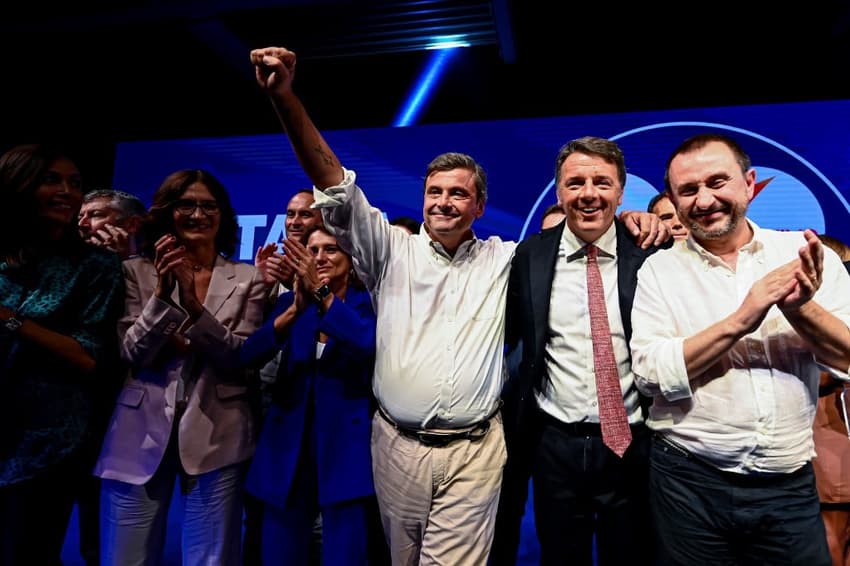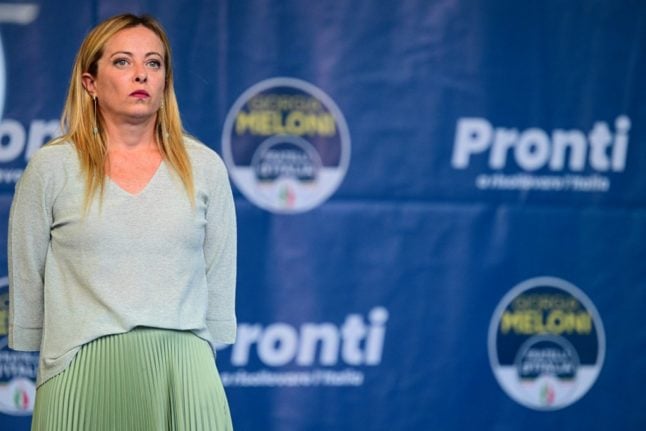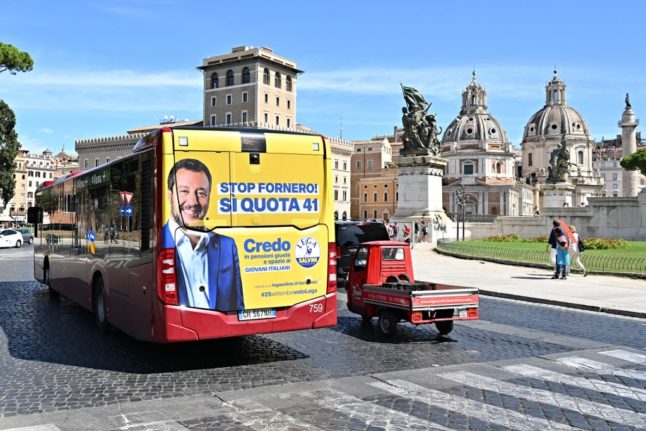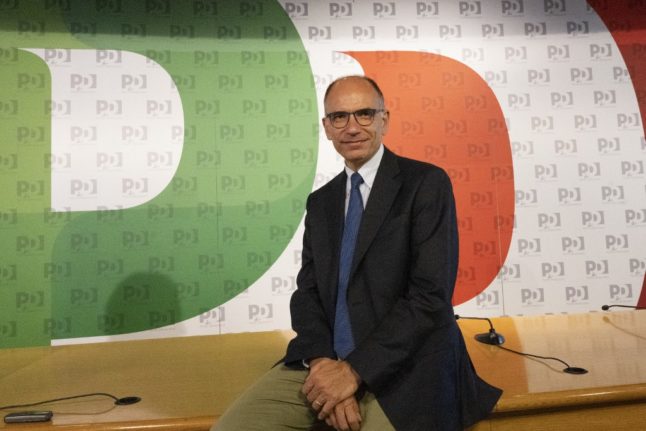EXPLAINED: Who's who in Italy's general election?

Want to know who the big names in Italian politics are and what they stand for ahead of the election? Here's a quick primer.
There are some names in Italian politics that have been around for so long they probably need no introduction, even if you live on the other side of the world. Silvio Berlusconi is one example that comes to mind.
But while this particularly controversial 85-year-old is now running for the Senate, and clearly has no retirement plans just yet, he's far from the biggest name to watch in Italy's elections on September 25th.
Italy has a large number of political parties and a complex electoral system, which means the country is often run by broad coalition governments featuring a mind-boggling number of parties, leaders, and political names that aren't always well known beyond Italy's borders.
This time around, the new government is at least likely to be on the less complicated side, with a coalition of 'only' two or three right-wing parties expected to win by a landslide.
So who are they? To help you follow the Italian election news this month, here's a brief look at the main parties and their leaders ahead of the vote.
Brothers of Italy (Fratelli d'Italia, or FdI)
Firstly the party everyone's talking about - but which few people outside of Italy had heard of until recently.
Brothers of Italy looks set to be the biggest winner at the upcoming election, meaning party leader Giorgia Meloni is the favourite to become Italy’s next prime minister.
READ ALSO: Who is Giorgia Meloni, Italy’s likely next prime minister?
The once-obscure party's popularity has soared over the past year, attracting the protest vote as it has been the only group in opposition to Mario Draghi’s national unity government.
Alternately described as a hard-right populist or post-fascist party, FdI's ideology can be hard to pin down. But its policies are strongly nationalist and conservative.
Meloni furiously denies being a “fascist” in interviews with Italian newspapers, despite the fact her party was born out of the National Alliance, which in turn was the successor of MSI, founded in 1946 by former members of the Italian Social Republic: the last incarnation of Mussolini's Italian Fascist regime. Meloni has herself in the past defended Mussolini, calling him a "good politician".
In her election campaigning today, Meloni plays to traditional identity politics with her signature slogan at rallies: “I am a woman, I am a mother, I am Italian, I am a Christian and you will not take that away from me.”

Brothers of Italy party leader Giorgia Meloni at an election rally in Ancona, central Italy, on August 23rd, 2022. Photo by Vincenzo PINTO / AFP
FdI is running for election as part of a right-wing alliance with the League and Forza Italia (see below), and their joint election manifesto leads with a promise to enact "foreign policy focused on the protection of the national interest and the defense of the homeland".
READ ALSO: Political cheat sheet: Understanding the Brothers of Italy
While it isn't in the manifesto, Meloni has repeatedly said on her social media accounts she wants to set up a ‘naval blockade’ to “put an end to illegal departures to Italy”.
The right-wing coalition is currently polling at around 48 percent, and is expected to win the election by a landslide - potentially forming a government with an unprecedented 'super majority' that would allow it to make changes to the political system itself, and therefore the constitution.
League
The right-wing populist League party, or Lega, led by Matteo Salvini, is famous for its hardline anti-immigration polices.
As well as closing ports and turning away rescue ships during his time as interior minister in 2018-2019, Salvini made Italian citizenship harder to obtain, and abolished the country’s humanitarian protection status for migrants under a so-called security decree.
Populist, nationalist politics now form the backbone of the party's identity, but this wasn't always the case.
For most of its life, the League was the Northern League (Lega Nord). The party began as a federation of regional separatist parties, pushing for greater autonomy for the north.
But before the 2018 general election, it changed its name and rebranded as a nationalist, nativist party, with ‘Italians first’ (Prima gli italiani) as its slogan. It apparently worked, as the party took power along with another populist party, the Five Star Movement.

League leader Matteo Salvini pictured on a campaign poster on the back of a bus in downtown Rome on September 2, 2022. Photo by Andreas SOLARO / AFP
Now, the League is standing for election as part of a hard-right, nationalist coalition along with Fratelli d'Italia and Forza Italia. Salvini, who often uses religious imagery in his campaigning in an attempt to appeal to the country's Catholic majority, is using the one-word slogan Credo ('I believe') on campaign posters.
As well as anti-immigration policies, their joint manifesto focuses on flat tax rates, cutting VAT, and raising pensions.
Read more about Italy's League party here.
Forza Italia (FI)
Silvio Berlusconi’s conservative party Forza Italia (the name is variously translated as 'Come on Italy' or 'Forward Italy') is running for election as part of the right-wing alliance, with Fratelli d'Italia and the League (see above).
Forza Italia is seen as the most moderate of the three, and may be the only one that could accurately be described as centre-right - though it has lost MPs who say it is becoming more hardline due to its ever-closer alliance with its coalition partners.
So what does it stand for? The party's own constitution says it is based on “the ideals of liberal democratic, liberal Catholic, secular and reformist European traditions”.
The party is much more pro-EU than its coalition allies. It also supports close relations with both Russia – Berlusconi and Russian President Vladimir Putin are old friends – and the United States.
It's pro-business, which is no surprise given Berlusconi's background as a media magnate, and pushes for low tax rates for business-owners and the wealthy. It has taken a swing to the right on migration since 2018.

Former Italian Prime Minister and leader of Forza Italia Silvio Berlusconi holds in Rome on March 9th, 2022. Photo by FILIPPO MONTEFORTE / AFP
The Democratic Party (Partito Democratico, PD)
The centre-left Democratic Party is Italy's second-biggest political party in terms of voter share this election, currently polling just behind FdI around 23 percent.
But unlike FdI, the PD has not formed a strong alliance ahead of the election - which in this election will be key to success.
PD's election manifesto is pro-Europe, and pro-immigration, proposing a new immigration law that would make it easier to legally relocate to Italy for work.
It also proposes introducing a €9 minimum wage and modest tax breaks, and raising certain unemployment benefits.
The party's current leader, Enrico Letta, is a former Italian prime minister and academic. The ideology of the PD can be hard to pin down due to the party's broad nature, but is inspired by social democracy.
As the name suggests, it draws inspiration from the American Democratic Party: ex-PM and former party leader Matteo Renzi was one of Barack Obama's closest international allies.
READ ALSO: Italian elections: What are the main parties’ policies for foreigners?

Enrico Letta, head of the centre-left Democratic Party (PD), at an interview with AFP in Rome on July 29th, 2022. (Photo by Tiziana FABI / AFP)
The party was in power most recently from 2013 to 2018, but the party's support and influence has dwindled since then.
Read more about Italy's Democratic Party here.
The Five Star Movement (Movimento Cinque Stelle, M5S)
If you followed Italy's 2018 elections, you'll have heard a lot about this party and how it swept to power from nowhere on a tide of protest votes. Unfortunately for supporters, it seems to be sinking back into oblivion almost as quickly.
The movement's anti-establishment, Eurosceptic programme proved popular with disaffected voters last time around, particularly in Italy's southern regions. But political experts say the party has been a victim of its own success.
After entering government in 2018 - and remaining a key part of successive governments for the past four years - M5S had to soften its stance on everything from the euro to environmental issues and, as its current election manifesto shows, it's somewhat unclear what the party now stands for.
The party, which says it is neither right- not left-wing, is currently polling at around 10-11 percent ahead of the election this month - which is a sharp drop from the 33 percent of the vote it took at the last election in 2018.
READ ALSO: ‘They’re all talk’: How the Five Star Movement lost southern Italy’s support
You'll no doubt recognise party leader Giuseppe Conte; the former university lecturer who gained international fame as he led Italy through the first part of the pandemic as prime minister in 2020. He wasn't M5S leader then, but the party hopes his personal popularity will now boost its election prospects.
Read more about the Five Star Movement here.

Current leader of the Five Star Movement, Giuseppe Conte, with former leader Luigi Di Maio in 2019. Photo by Alberto PIZZOLI / AFP
Italia Viva (IV)
Italia Viva (meaning 'Italy alive') is a smaller, relatively new party that sits in the political centre, with an election manifesto focused on tax reform, "sustainable economic growth", and "equal opportunities for all" and aiming to present the party as the sensible face of Italian politics.
The party was founded and is led by Matteo Renzi, the ex-prime minister and former PD leader and who left to form Italia Viva in 2017.
In fact Renzi has a reputation for bringing down governments (most notably his own in 2016, and then he did it again in 2021 to a coalition Italia Viva was part of), and as such is nicknamed Il rottomatore (the wrecker).
This, and his arrogant political style, has led some people to say he's eternally vying for the heavily-contested position of Italy's most disliked politician.
But all this hasn't stopped Italia Viva from being one of the more influential smaller political parties; it's now polling at around five percent as part of an alliance with the centrist Azione party, led by Carlo Calenda, which is campaigning under the slogan Italia, sul serio ('Italy, seriously'.)
 Leader of Azione, Carlo Calenda (L) and Italia Viva, Matteo Renzi, in Milan on September 2, 2022 during the launch of their election campaign. Photo by Piero CRUCIATTI / AFP
Leader of Azione, Carlo Calenda (L) and Italia Viva, Matteo Renzi, in Milan on September 2, 2022 during the launch of their election campaign. Photo by Piero CRUCIATTI / AFP
Find all the latest news on Italy’s election race here.
Comments (1)
See Also
There are some names in Italian politics that have been around for so long they probably need no introduction, even if you live on the other side of the world. Silvio Berlusconi is one example that comes to mind.
But while this particularly controversial 85-year-old is now running for the Senate, and clearly has no retirement plans just yet, he's far from the biggest name to watch in Italy's elections on September 25th.
Italy has a large number of political parties and a complex electoral system, which means the country is often run by broad coalition governments featuring a mind-boggling number of parties, leaders, and political names that aren't always well known beyond Italy's borders.
This time around, the new government is at least likely to be on the less complicated side, with a coalition of 'only' two or three right-wing parties expected to win by a landslide.
So who are they? To help you follow the Italian election news this month, here's a brief look at the main parties and their leaders ahead of the vote.
Brothers of Italy (Fratelli d'Italia, or FdI)
Firstly the party everyone's talking about - but which few people outside of Italy had heard of until recently.
Brothers of Italy looks set to be the biggest winner at the upcoming election, meaning party leader Giorgia Meloni is the favourite to become Italy’s next prime minister.
READ ALSO: Who is Giorgia Meloni, Italy’s likely next prime minister?
The once-obscure party's popularity has soared over the past year, attracting the protest vote as it has been the only group in opposition to Mario Draghi’s national unity government.
Alternately described as a hard-right populist or post-fascist party, FdI's ideology can be hard to pin down. But its policies are strongly nationalist and conservative.
Meloni furiously denies being a “fascist” in interviews with Italian newspapers, despite the fact her party was born out of the National Alliance, which in turn was the successor of MSI, founded in 1946 by former members of the Italian Social Republic: the last incarnation of Mussolini's Italian Fascist regime. Meloni has herself in the past defended Mussolini, calling him a "good politician".
In her election campaigning today, Meloni plays to traditional identity politics with her signature slogan at rallies: “I am a woman, I am a mother, I am Italian, I am a Christian and you will not take that away from me.”

FdI is running for election as part of a right-wing alliance with the League and Forza Italia (see below), and their joint election manifesto leads with a promise to enact "foreign policy focused on the protection of the national interest and the defense of the homeland".
READ ALSO: Political cheat sheet: Understanding the Brothers of Italy
While it isn't in the manifesto, Meloni has repeatedly said on her social media accounts she wants to set up a ‘naval blockade’ to “put an end to illegal departures to Italy”.
The right-wing coalition is currently polling at around 48 percent, and is expected to win the election by a landslide - potentially forming a government with an unprecedented 'super majority' that would allow it to make changes to the political system itself, and therefore the constitution.
League
The right-wing populist League party, or Lega, led by Matteo Salvini, is famous for its hardline anti-immigration polices.
As well as closing ports and turning away rescue ships during his time as interior minister in 2018-2019, Salvini made Italian citizenship harder to obtain, and abolished the country’s humanitarian protection status for migrants under a so-called security decree.
Populist, nationalist politics now form the backbone of the party's identity, but this wasn't always the case.
For most of its life, the League was the Northern League (Lega Nord). The party began as a federation of regional separatist parties, pushing for greater autonomy for the north.
But before the 2018 general election, it changed its name and rebranded as a nationalist, nativist party, with ‘Italians first’ (Prima gli italiani) as its slogan. It apparently worked, as the party took power along with another populist party, the Five Star Movement.

Now, the League is standing for election as part of a hard-right, nationalist coalition along with Fratelli d'Italia and Forza Italia. Salvini, who often uses religious imagery in his campaigning in an attempt to appeal to the country's Catholic majority, is using the one-word slogan Credo ('I believe') on campaign posters.
As well as anti-immigration policies, their joint manifesto focuses on flat tax rates, cutting VAT, and raising pensions.
Read more about Italy's League party here.
Forza Italia (FI)
Silvio Berlusconi’s conservative party Forza Italia (the name is variously translated as 'Come on Italy' or 'Forward Italy') is running for election as part of the right-wing alliance, with Fratelli d'Italia and the League (see above).
Forza Italia is seen as the most moderate of the three, and may be the only one that could accurately be described as centre-right - though it has lost MPs who say it is becoming more hardline due to its ever-closer alliance with its coalition partners.
So what does it stand for? The party's own constitution says it is based on “the ideals of liberal democratic, liberal Catholic, secular and reformist European traditions”.
The party is much more pro-EU than its coalition allies. It also supports close relations with both Russia – Berlusconi and Russian President Vladimir Putin are old friends – and the United States.
It's pro-business, which is no surprise given Berlusconi's background as a media magnate, and pushes for low tax rates for business-owners and the wealthy. It has taken a swing to the right on migration since 2018.

The Democratic Party (Partito Democratico, PD)
The centre-left Democratic Party is Italy's second-biggest political party in terms of voter share this election, currently polling just behind FdI around 23 percent.
But unlike FdI, the PD has not formed a strong alliance ahead of the election - which in this election will be key to success.
PD's election manifesto is pro-Europe, and pro-immigration, proposing a new immigration law that would make it easier to legally relocate to Italy for work.
It also proposes introducing a €9 minimum wage and modest tax breaks, and raising certain unemployment benefits.
The party's current leader, Enrico Letta, is a former Italian prime minister and academic. The ideology of the PD can be hard to pin down due to the party's broad nature, but is inspired by social democracy.
As the name suggests, it draws inspiration from the American Democratic Party: ex-PM and former party leader Matteo Renzi was one of Barack Obama's closest international allies.
READ ALSO: Italian elections: What are the main parties’ policies for foreigners?

The party was in power most recently from 2013 to 2018, but the party's support and influence has dwindled since then.
Read more about Italy's Democratic Party here.
The Five Star Movement (Movimento Cinque Stelle, M5S)
If you followed Italy's 2018 elections, you'll have heard a lot about this party and how it swept to power from nowhere on a tide of protest votes. Unfortunately for supporters, it seems to be sinking back into oblivion almost as quickly.
The movement's anti-establishment, Eurosceptic programme proved popular with disaffected voters last time around, particularly in Italy's southern regions. But political experts say the party has been a victim of its own success.
After entering government in 2018 - and remaining a key part of successive governments for the past four years - M5S had to soften its stance on everything from the euro to environmental issues and, as its current election manifesto shows, it's somewhat unclear what the party now stands for.
The party, which says it is neither right- not left-wing, is currently polling at around 10-11 percent ahead of the election this month - which is a sharp drop from the 33 percent of the vote it took at the last election in 2018.
READ ALSO: ‘They’re all talk’: How the Five Star Movement lost southern Italy’s support
You'll no doubt recognise party leader Giuseppe Conte; the former university lecturer who gained international fame as he led Italy through the first part of the pandemic as prime minister in 2020. He wasn't M5S leader then, but the party hopes his personal popularity will now boost its election prospects.
Read more about the Five Star Movement here.

Current leader of the Five Star Movement, Giuseppe Conte, with former leader Luigi Di Maio in 2019. Photo by Alberto PIZZOLI / AFP
Italia Viva (IV)
Italia Viva (meaning 'Italy alive') is a smaller, relatively new party that sits in the political centre, with an election manifesto focused on tax reform, "sustainable economic growth", and "equal opportunities for all" and aiming to present the party as the sensible face of Italian politics.
The party was founded and is led by Matteo Renzi, the ex-prime minister and former PD leader and who left to form Italia Viva in 2017.
In fact Renzi has a reputation for bringing down governments (most notably his own in 2016, and then he did it again in 2021 to a coalition Italia Viva was part of), and as such is nicknamed Il rottomatore (the wrecker).
This, and his arrogant political style, has led some people to say he's eternally vying for the heavily-contested position of Italy's most disliked politician.
But all this hasn't stopped Italia Viva from being one of the more influential smaller political parties; it's now polling at around five percent as part of an alliance with the centrist Azione party, led by Carlo Calenda, which is campaigning under the slogan Italia, sul serio ('Italy, seriously'.)

Find all the latest news on Italy’s election race here.
Join the conversation in our comments section below. Share your own views and experience and if you have a question or suggestion for our journalists then email us at [email protected].
Please keep comments civil, constructive and on topic – and make sure to read our terms of use before getting involved.
Please log in here to leave a comment.